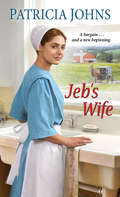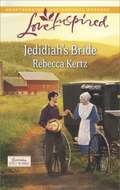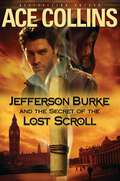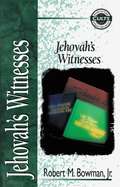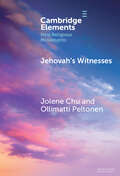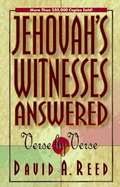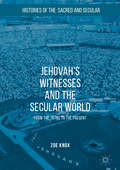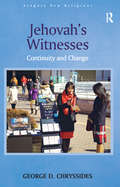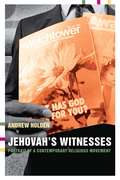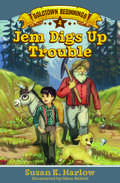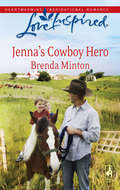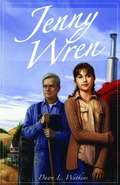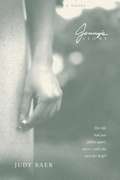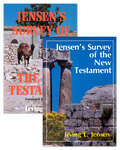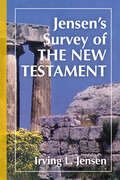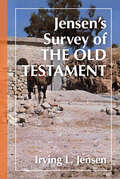- Table View
- List View
Jean-Luc Marion: A Theo-logical Introduction
by Robyn HornerJean-Luc Marion is one of the leading Catholic thinkers of our time: a formidable authority on Descartes and a major scholar in the philosophy of religion. This book presents a concise, accessible, and engaging introduction to the theology of Jean-Luc Marion. Described as one of the leading thinkers of his generation, Marion's take on the postmodern is richly enhanced by his expertise in patristic and mystical theology, phenomenology, and modern philosophy. In this first introduction to Marion's thought, Robyn Horner provides the essential background to Marion's work, as well as analysing the most significant themes for contemporary theology. This book serves as an ideal starting point for students of theology and philosophy, as well as for those seeking to further their knowledge of cutting-edge thinking in contemporary theology.
Jeb's Wife
by Patricia JohnsPatricia Johns&’ sensitive storytelling brings depth and heart to this tender story of second chances, as an Amish woman embarks on marriage with the gruff farmer next door . . . Once, Leah Riehl prayed for a husband. The man she loved chose another, wanting the children that Leah can&’t provide. But she&’s found a measure of peace, keeping house for her brother, Simon, and teaching in a nearby town. Now though, Simon&’s debts to an Englisher gambling ring have left Leah with a desperate dilemma—and a surprising offer from her scarred, reclusive neighbor. Jebadiah King needs to marry in order to claim his family farm. A union, for appearances only, will help them both. Jeb knows his scars make him a less than ideal husband, but he can be a useful one. It&’s the least that Leah deserves. But despite the promises he made to himself, Jeb can&’t help longing for his lovely, warmhearted new wife. His first marriage brought heartbreak, but Leah&’s gentle smiles spark hope again. Are they willing to take the leap that love requires—and open themselves to all the challenges and joy a true marriage could bring?
Jedidiah's Bride
by Rebecca KertzA Place of Their Own When handsome stranger Jedidiah Lapp saves her twin brothers' lives, Sarah Mast offers him her heartfelt thanks. And a cherry pie! But she never expects to see him again. When they meet once more at Sunday services, Sarah begins to feel something special for him. Jedidiah is eager to know the blushing beauty, and asks permission to court her. Soon, he can see Sarah as part of his future. But her family is in Delaware, his in Pennsylvania. Dare he ask her to leave all she knows behind for him and build a life in Happiness, Pennsylvania?
Jedidiah's Bride & Plain Threats
by Alison Stone Rebecca KertzTwo Amish tales of redemption and love Jedidiah's Bride by Rebecca Kertz When handsome stranger Jedidiah Lapp saves her twin brothers' lives, Sarah Mast never expects to see their hero again. When they meet once more, Sarah begins to feel something special for him. Jedidiah soon sees Sarah as part of his future, too. But dare he ask her to leave her family behind and build a life with him? Plain Threats by Alison Stone More than a year after her husband was accused of murder and died in prison, someone is reminding Amish widow Rebecca Fisher that all hasn't been forgiven. Turning to Englisher and former army ranger Jake Burke for help rattles her traditional community. But before long, Rebecca senses Jake is the only person she can trust with her safety...and her fragile heart.
Jeepers Creepers: Canadian Accounts of Weird Events and Experiences
by John Robert ColomboHere are over 40 scary, hair-raising, and frightening stories of the supernatural and the paranormal. These are first-person narratives that are unexplained and possibly inexplicable. All of them have been reported to John Robert Colombo, Canada’s Master Gatherer of the Arcane, by men and women from various parts of the country, and they’re published here in the words of the informants themselves, the witnesses to these wonders. Here, you will have the opportunity to read about:A woman from Ottawa who is visited nightly by her dead husband.A man from Quebec who is haunted by visions of the past.The couple from Regina, Saskatchewan, who commune with spirits through a Ouija board.The woman from Newcastle, Ontario, who finds the house of her dreams with a terrible secret.
Jefferson Burke and the Secret of the Lost Scroll
by Ace CollinsJefferson Burke and the Secret of the Lost Scroll is a mystery as old as the Christian church wrapped in a modern-day thriller. Though an unwilling hero, professor Jefferson Burke's intellectual curiosity pits him against the powerful Bruno Krueger in a race to find a 2000-year-old scroll that calls into question the divinity of Christ and could shake the foundation of Christian faith, upsetting the balance of power in the modern world. Their deadly quest spans the globe, involving officials from the Vatican, CIA and FBI agents, British royalty, a Hollywood actress, and modern terrorists. This classic battle of good vs. evil will hook believers and doubters alike. The uncertainties raised by the very existence of the elusive scroll will have every reader questioning the basis of their faith and wondering what would happen if certain fundamental truths suddenly were proven untrue. Artfully and thoughtfully told, this is the kind of action-packed adventure story that will keep loyal Ace Collins readers—and increasing legions of new fans—coming back for more.
Jehovah's Witnesses
by Robert M. Bowman Jr. Alan W. GomesThe zeal and dedication of Jehovah's Witnesses mask a highly disciplined organization that has a troubled history. Moreover, their thorough knowledge of their own scriptures gives a pretense of having spiritual truth. The movement has grown from about 1.1 million worldwide in 1965 to 4.4 million today. Yet all is not what it seems in the Watchtower Society. How do the teachings of the Jehovah's Witnesses run counter to orthodox Christianity? What drives adherents to give hundreds of hours a year to "witnessing"? What draws converts to a cult of strict control by religious leaders? Why this series? This is an age when countless groups and movements, old and new, mark the religious landscape in our culture, leaving many people confused or uncertain in their search for spiritual truth and meaning. Because few people have the time or opportunity to research these movements fully, these books provide essential information and insights for their spiritual journeys. Each book has five sections: - A concise introduction to the group - An overview of the group's theology -- in its own words - Tips for witnessing effectively to members of the group - A bibliography with sources for further study - A comparison chart that shows the essential differences between biblical Christianity and the group -- The writers of these volumes are well qualified to present clear and reliable information and help us discern religious truth from falsehood.
Jehovah's Witnesses (Elements in New Religious Movements)
by Jolene Chu Ollimatti PeltonenJehovah's Witnesses began as an informal Bible study group in the 1870s that sought to recover first-century Christian beliefs and practices. They disseminated literature announcing the expected reign of God's Kingdom and called themselves Bible Students. In 1931, they adopted the name Jehovah's Witnesses, epitomizing their belief in the Christian obligation to preach the gospel worldwide. Known for their ethic of nonviolence and their evangelizing work, and despite worshipping freely in most countries, Witnesses are subject to controversy, particularly vis-à-vis mainstream Christianity, the State, and secularized societies. The authors are practicing Jehovah's Witnesses who present this work as neither apologia nor official account, but as an emic description of the history, beliefs, identity, and organizational structure of Witnesses, and their societal interactions. While briefly covering main controversies, this Element focuses on the culture and lived experience of the millions comprising the Witness community. This title is also available as Open Access on Cambridge Core.
Jehovah's Witnesses Answered Verse by Verse
by David A. ReedA handbook for responding to Jehovah's Witnesses claims based on Scripture. Written by a former JW elder.
Jehovah's Witnesses and the Secular World
by Zoe KnoxThis book examines the historic tensions between Jehovah's Witnesses and government authorities, civic organisations, established churches and the broader public. Witnesses originated in the 1870s as small, loose-knit groups calling themselves Bible Students. Today, there are some eight million Witnesses worldwide, all actively engaged in evangelism under the direction of the Watch Tower Society. The author analyses issues that have brought them global visibility and even notoriety, including political neutrality, public ministry, blood transfusion, and anti-ecumenism. It also explores anti-Witness discourse, from media portrayals of the community as marginal and exotic to the anti-cult movement. Focusing on varied historical, ideological and national contexts, the book argues that Witnesses have had a defining influence on conceptions of religious tolerance in the modern world.
Jehovah's Witnesses: Continuity and Change (Routledge New Religions)
by George D. ChryssidesFrom its origins in nineteenth century Adventism until the present day, the Watch Tower Society has become one of the best known but least understood new religious movements. Resisting the tendency to define the movement in terms of the negative, this volume offers an empathetic account of the Jehovah's Witnesses, without defending or seeking to refute their beliefs. George Chryssides critically examines the historical and theological bases of the organization's teachings and practices, and discusses the changes and continuities which have defined it. The book provides a valuable resource for scholars of new religious movements and contemporary religion.
Jehovah's Witnesses: Portrait of a Contemporary Religious Movement
by Andrew HoldenThis is the first major study of the enigmatic religious society. By examining the Jehovah's Witnesses' dramatic recent expansion, Andrew Holden reveals the dependency of their quasi-totalitarian movement on the physical and cultural resources have brought about the privatization of religion, the erosion of community, and the separation of 'fact' from faith.
Jehu’s Tribute: What Can Biblical Studies Offer Assyriology? (Explorations in Ancient Near Eastern Civilizations)
by Jeffrey L. Cooley Rannfrid I. Lasine ThelleThe findings of Assyriology have been applied to biblical studies ever since the former emerged as a scholarly discipline in the mid-nineteenth century. Today, the scholarly flow from Assyriology to biblical studies continues, yet rarely are the fruits of biblical scholarship brought to bear on the study of ancient Assyria and Babylon. The present volume aims to reverse this unidirectional trend.Considering that the literature preserved in the Hebrew Bible is the product of a people who had significant contact with both Assyria and Babylonia, then surely the study of the Hebrew Bible has something to offer Assyriology. But what? The contributors approach this question from a variety of disciplinary perspectives, including intellectual history, museology, and religious and political history. The authors also offer broad methodological considerations and more focused, text-based case studies. Written by leading scholars in the fields of Assyriology and Hebrew Bible, Jehu’s Tribute presents a fresh approach to the multifaceted relationship between Assyriology and biblical studies.In addition to the volume editors, the contributors include Céline Debourse, Jessie DeGrado, Eckart Frahm, Shalom E. Holtz, Gina Konstantopoulos, Alan Lenzi, Alice Mandell, Dustin Nash, Beate Pongratz-Leisten, Seth Sanders, Anthony P. SooHoo, SJ, and Abraham Winitzer.
Jem Digs Up Trouble (Goldtown Beginnings #4)
by Susan K. MarlowJem is turning eight years old. And there's just one thing he wants for his birthday: a prospecting trip with Strike-it-rich Sam. With his grown-up friend to watch out for him, Jem's parents say yes. It's off for two weeks in the mountains to find gold!But this trip isn't going as planned. There are more tall tales from Sam than there are deep pockets of gold ore. And the map to rich diggings they brought along doesn't have any treasure at the end of it. Striking it rich is a lot harder than it looks.When they find an unexpected cache, things seem to be looking up. But Jem and Sam shouldn't count their gold nuggets before they get home. An injury, a bad detour, and other problems plague them. Not only are they empty-handed, they might never make it home at all!
Jem and the Mystery Thief (Goldtown Beginnings #3)
by Susan K. MarlowJem can't wait for school to let out for the year. Is there anything more boring than class when you could be outside? When rich boy Will brings a coin collection to school, it's an exciting treat. It isn't often the students get to see all that interesting money in one place.Then a silver dollar goes missing during recess--and Jem is blamed! After all, he's the only one who went indoors on this sunny day. When a charm bracelet is stolen the next day, more fingers point his way.Jem knows he isn't the culprit. But how can he prove it? To clear his name, Jem sets a trap for the mystery thief--his sister's gold locket lays in plain sight on his desk as bait. Will it go missing too? Or will Jem's good name be muddied forever?
Jenna's Cowboy Hero
by Brenda MintonFormer football player Adam Mackenzie arrives in small-town Oklahoma to fix up a camp for underprivileged kids. But the city slicker doesn't know horse tack from a touchdown. He's desperate for help—and the pretty rancher next door is the answer to his prayers. War vet Jenna is back home after a stint in Iraq, and she's got a five-year plan: raising her twin boys, running her ranch—and not falling in love. But she can't say no to gorgeous and kind Adam. Can he make her forget all her plans and open her heart to love?
Jennifer: An O'Malley Love Story
by Dee HendersonEagerly Awaited Novella from Dee Henderson. It's a summer of change for Jennifer O'Malley. The busy physician has a pediatrics practice in Dallas, and meeting Tom Peterson, and falling in love, is adding a rich layer to her life. She's sorting out how to introduce him to her family--she's the youngest of seven--and thinking about marriage. She's falling in love with Jesus too, and knows God is good. But that faith is about to be tested in a way she didn't expect, and the results will soon transform her entire family.
Jenny Wren
by Dawn L. WatkinsJenny Wren, a welfare child, comes to stay with an old farmer and his wife despite the misgivings of some officials. At first silent and distrustful, Jenny warms to the Logans, learning from them about logging, farming, and love. When confronted with a change too hard for her to accept, however, Jenny runs away. When she wants to go back, she finds that she has done more damage than she had thought. Now her home may change again, but Jenny learns the most important thing of all.
Jenny's Story
by Judy BaerJenny Owens staggers into widowhood a young and bitter woman. Her husband, Lee, has just died unexpectedly, and she wonders where she will find the strength to go on. Then just as Jenny begins to recover from her emotional loss, a deeper, darker truth is revealed. And what part does her childhood friend Mike play in the unfolding events? With the support of her two best friends, Libby and Tia, Jenny learns that love can triumph over incredible odds.
Jensen Survey-2 Volume Set -Old and New Testaments
by Irving L. JensenThis package includes the complete two-volume set of Jensen's Survey of the Testaments: Jensen's Survey of the Old Testament and Jensen's Survey of the New Testament.In Jensen's Survey of the Old Testament, the author provides a useful survey of the Old Testament that will aid in understanding difficult passages. This one volume contains all of Irving Jensen's Bible self-study guides to the Old Testament. In Jensen's Survey of the New Testament, Jensen leads the reader to study and personal reflection, considering the practical implications of Scripture. This one volume contains all of Irving Jensen's Bible self-study guides to the New Testament.
Jensen Survey-2 Volume Set -Old and New Testaments
by Irving L. JensenThis package includes the complete two-volume set of Jensen's Survey of the Testaments: Jensen's Survey of the Old Testament and Jensen's Survey of the New Testament.In Jensen's Survey of the Old Testament, the author provides a useful survey of the Old Testament that will aid in understanding difficult passages. This one volume contains all of Irving Jensen's Bible self-study guides to the Old Testament. In Jensen's Survey of the New Testament, Jensen leads the reader to study and personal reflection, considering the practical implications of Scripture. This one volume contains all of Irving Jensen's Bible self-study guides to the New Testament.
Jensen's Survey of the New Testament
by Irving L. JensenLeads the reader to study and personal reflection, considering the practical implications of Scripture. This one volume contains all of Irving Jensen's Bible self-study guides to the New Testament.
Jensen's Survey of the New Testament
by Irving L. JensenLeads the reader to study and personal reflection, considering the practical implications of Scripture. This one volume contains all of Irving Jensen's Bible self-study guides to the New Testament.
Jensen's Survey of the Old Testament
by Irving L. JensenA useful survey of the Old Testament that will aid in understanding difficult passages. This one volume contains all of Irving Jensen's Bible self-study guides to the Old Testament.
Jensen's Survey of the Old Testament
by Irving L. JensenA useful survey of the Old Testament that will aid in understanding difficult passages. This one volume contains all of Irving Jensen's Bible self-study guides to the Old Testament.

